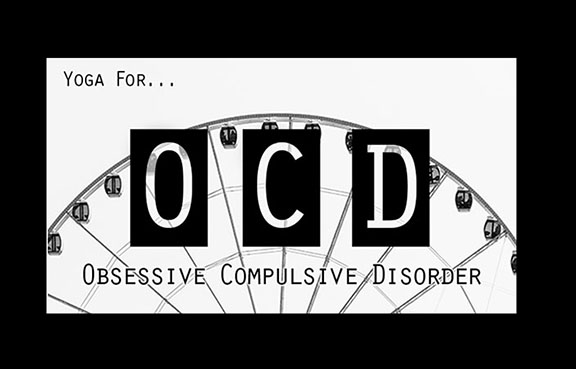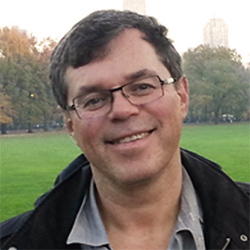 Based on his personal experience with obsessive-compulsive disorder (OCD), panic attacks and anxiety, Boris Bhagavan Pisman, MS, NCC, developed a Yoga-based approach to recovery. In this interview, he talks about his journey and how he integrates the best of Yoga psychology and cognitive-behavioral therapy (CBT) into a holistic treatment model.
Based on his personal experience with obsessive-compulsive disorder (OCD), panic attacks and anxiety, Boris Bhagavan Pisman, MS, NCC, developed a Yoga-based approach to recovery. In this interview, he talks about his journey and how he integrates the best of Yoga psychology and cognitive-behavioral therapy (CBT) into a holistic treatment model.
Integral Yoga Magazine: Is it true that panic attacks led you to Yoga?
Boris Pisman: Yes, I was 22 years-old and I was looking for an alternative to medication. Someone suggested Yoga, and I tried different types and what appealed to me most was Integral Yoga. I liked the system, the simplicity and the relaxation part of the class. I practiced pranayama, relaxation and meditation very seriously and regularly and, after about a year, the panic attacks finally went away. Then, I took all three levels of Integral Yoga Hatha teacher training (TT) and meditation TT.
I was able to relax, and I was doing a lot of pranayama and asanas. I was teaching Hatha Yoga and meditation, but I still felt an underlying anxiety. I was kind of desperate because I wanted to be anxiety-free. I would follow Sri Gurudev Swami Satchidananda around as much as possible. When he would come to New York, I would have the opportunity to drive him around and I would ask him questions about my anxiety. He said, “Some people have screws too loose, and you have screws too tight. You are not your thoughts, not your emotions.” His guidance led me to delve deep into the study of Jnana Yoga. I visited Ramana Maharshi’s ashram, studied Krishnamurti, Andrew Cohen and others who teach the Advaita Vedanta and Jnana Yoga approaches.
IYM: Did Jnana Yoga help?
BP: Yes, it helped me refuse to engage my thoughts. That was the first step. The second step was that I decided to stop judging my thoughts. It’s not so simple because on the spiritual path we try and have good thoughts. But, I tried to change the relationship with my thoughts. Instead of reacting to them, I’d do nothing about them; I would just let the thoughts exist. The difficult part was not to make a big deal about it when I would react with anxiety to the thoughts. Usually, I felt there was something wrong since I felt anxious, but, I’d decide to let the emotion exist and not so much watch it as just to do nothing about it. This is the heart of Advaita, as Gurudev said: I am not my thoughts, not my emotions—and I embraced that. Yoga says we are divine; we are perfect. The divine person is not affected by thoughts and emotions. I kept practicing not to be involved with my thoughts, not to add more stories.
When I truly started to not engage my thoughts and emotions, I was able to quiet the mind because there was no conflict. Conflict was created when I added to the anxious, intrusive thoughts. If I didn’t add, they went back to where they came from and with time, as Gurudev said, if you don’t give them energy they slowly dry out. It’s a serious and challenging work because we are so conditioned, so it’s difficult to not engage the thoughts. My diseased, anxious ego began to settle down as I stopped responding to the thoughts. When I left them alone, I could be more peaceful about the intrusive ones. I stopped getting the “me” involved. When the ego wants to be involved, it’s hard work, but when I let go of my will and just paid attention to what was happening, I found I got stronger and stronger and less anxious.
IYM: At what point did you decide to get a degree in counseling?
BP: Since I was finding relief through Yoga, I wanted to share what had helped me. But to work with others, I needed the “credentials.” In graduate school, I found that the cognitive therapies were very beneficial in working with anxiety because they helped me identify my thoughts and deeply ingrained beliefs. Once I was able to identify them, I was able to let go of them through meditation and Jnana Yoga. I realized that combining Yoga with CBT gave me about 95 percent relief.
Once I graduated, I began teaching a workshop and started seeing people privately. My workshop teaches people to relax first, and how to use breathing practices to relax the nervous system and then I teach them cognitive techniques: identifying intrusive and anxious thoughts and mental desensitization. I teach what I call “meditative psychology,” awareness and how not to engage thoughts. In meditative psychology, you are taught not to engage the thoughts. Advaita Vedanta tells us we are not our thoughts. I also teach some behavioral therapy—how to do exposure therapy in order to change the behaviors. It’s very effective. It’s a combination of East and West and based on Yoga and Swami Satchidananda’s teachings as well as those of Krishnamurti. After the workshop, they can use this with their own therapists or consult me privately for refreshers.
IYM: How open to Yoga therapy were those at the clinic where you worked?
BP: Many therapists don’t like to work with OCD patients because they don’t see them getting better. Even though the director, a psychiatrist, said when he met me, “Only CBT and medication works. Yoga won’t work,” he was happy to have me work with the OCD patients because the hospital was desperate for counselors who would! When I said I wanted to work with OCD patients, they were happy, they supported me and said, “Do whatever you want.” Subsequently, they saw good results from my work. And now a lot of people believe in alternative medicine and are supportive. In New York, Yoga is widely practiced and a lot of clinics use some kind of relaxation and meditation techniques. Many use Yoga for stress management, so integrating Yoga therapy into clinical work in New York is usually not an issue. The cognitive therapies are incorporating a lot of mindfulness with their treatments nowadays because it allows people to withstand strong emotions better. If you can withstand strong emotions you can let go of them eventually.
IYM: How have you adapted Yoga and how effective is it with medicated patients?
BP: I usually don’t do esoteric practices but I teach them relaxation through Yoga Nidra and I teach them to withstand their strong emotions. Most people hate to be anxious. I work with smart people who have anxiety. When they are sick of it, they want to try alternative methods, and meditative psychology is perfect for this. My program works very well and the results and feedback are excellent, so I always tell my students and patients that we will do CBT first, but ultimately that they will need to apply Yoga philosophy to not have relapses and setbacks. Western therapy often encourages the validity of thoughts: “I’m thinking this, so, there must be something wrong with me.” So, people spend years in therapy validating their intrusive and anxious thoughts and images. Even if you know why you think certain things, one should learn how to let go of them. Meditative psychology says that thoughts don’t represent who you are. It teaches about thoughts being impermanent and not being real. Psychology is like a big ship, but sometimes it takes you out in the ocean, and you have to get out into the little boat and start rowing yourself. Ultimately, for someone to feel steady, they should incorporate meditative psychology.
A lot of the patients I’ve worked with were heavily medicated, so the progress was slower. Meds don’t let them experience the anxiety and so they don’t get desensitized as fast. Some who were on meds a long time felt a little bit hopeless. I believe anxiety is not just psychological but biological, too. I’m not against meds, but you can change your chemistry by changing your thoughts. A lot of people use meds like water wings—they are learning to swim and then they start applying the techniques and get stronger—and some will reduce or stop their meds. Some may stay on meds for the rest of their lives; I don’t judge. As long as they don’t experience pain and suffering, I’m okay with that.
IYM: How effective are Yoga-based therapies with types of anxiety other than OCD?
BP: They work very well with PTSD but not as well with phobias. A phobia is a strong conditioned response that can be best treated with exposure therapy, behavioral therapy, though some relaxation can be useful. For OCD and general anxiety, health anxiety, and religious anxiety, Yoga is very good—but, patients first have to be sick and tired of their anxiety. They have to be willing to really try to change. My job basically is to begin to make them humble in regard to their thoughts and realize that not every thought and belief is correct.
IYM: Do you encourage patients to practice Hatha Yoga?
BP: Some people aren’t comfortable doing Hatha, but I will teach them some Hatha as a tool to use when they are thinking anxious thoughts. For example, if I work with someone who has health anxiety and is afraid they will get some serious illness, they often monitor their body to see if they have symptoms. I will introduce Yoga Nidra so, when they monitor the body, they relax it. Then I teach nadi suddhi (alternate nostril breathing) and tell them to do it for five minutes in the morning. Deergha swasam (deep, three-part breathing) and nadi suddhi, along with stomach lifts can really help relax the stomach muscles, so I often teach these. The anxiety can be so deep inside, and agnisara dhauti helps relax the solar plexus. Hatha Yoga can be a great way to release tension, and I give my clients complimentary passes to take Hatha classes at the Integral Yoga Institute.
 About Boris Bhagavan Bisman:
About Boris Bhagavan Bisman:
Boris Pisman, MS, NCC is a New York State Licensed Mental Health Counselor. Prior to opening his private practice, he worked for over nine years as a therapist at White Plains Hospital, Westchester, NY. He was featured on NBC’s “Today Show.” Boris has over twenty years of Yoga teaching experience. He offers programs at the Integral Yoga Institute of New York and Yogaville. For more information, please visit: treatocd.com.

